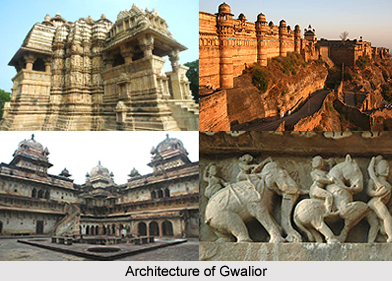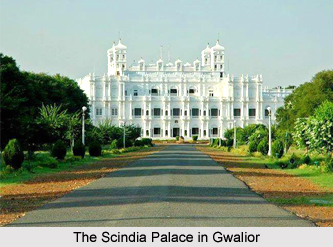 Gwalior in the state of Madhya Pradesh was originally a Hindu kingdom until Iltutmish occupied it and brought in Islamic rule in 1232. Mansingh of the Tomar family of Rajputs recaptured it and built the present Gwalior fort. In 1516, it was taken over by the Lodhi dynasty in India and then by the Mughals dynasty.
Gwalior in the state of Madhya Pradesh was originally a Hindu kingdom until Iltutmish occupied it and brought in Islamic rule in 1232. Mansingh of the Tomar family of Rajputs recaptured it and built the present Gwalior fort. In 1516, it was taken over by the Lodhi dynasty in India and then by the Mughals dynasty.
In 1754, Marathas occupied it, until 1804, when the British East India Company took over. Thus, Gwalior has been the seat of power to many dynasties and kingdoms, which is reflected, in its diverse architectural style. Every religion and age has left behind its own legacy. There is an intermingling of construction style seen in the monuments of Gwalior. There are Hindu temples, Jain cave temples and also Islamic buildings in Gwalior.
 The Tomb of Muhammad Ghaus in Gwalior is a splendid Rajput architectural creation. It is a square building where each side measures thirty meters, it has in the corner and the middle of every side, chhatris atop extended construction, which gives the impression of a very complex structure. The outer part looks like walls, but are actually stone lattice screens. From inside, the stone lattice screen look astounding. The tomb has thick walls around it and a big dome clad with blue tiles, surmounting it. In the south of the city of Gwalior, there is an area called Chhatri bazaar, where, within a wide garden are some royal tombs built in the 19th century. The biggest, the tomb of Sayyaji Rao, is at the far end of a rectangular hall and has vertical shikharas crowning the roof. The tomb of Jiwaji Rao, who died earlier is small, but of a superior quality. The interior walls are painted with colourful murals. The Man Mandir palace is one of the most beautiful Fort palaces of the Hindu kingdom. To the left of the entrance gate is the group of temples and to the right is the palace complex. Man Mandir, made of yellow sandstone, has on its walls, green and yellow tiles with blue tiles as the main colour.Man Mandir palace of Gwalior, Madhya Pradesh Inside, various rooms open onto two courtyards. Islamic influence is minimal and the delicate stone carving, though quite fantastic in appearance, differs from West Indian palaces.
The Tomb of Muhammad Ghaus in Gwalior is a splendid Rajput architectural creation. It is a square building where each side measures thirty meters, it has in the corner and the middle of every side, chhatris atop extended construction, which gives the impression of a very complex structure. The outer part looks like walls, but are actually stone lattice screens. From inside, the stone lattice screen look astounding. The tomb has thick walls around it and a big dome clad with blue tiles, surmounting it. In the south of the city of Gwalior, there is an area called Chhatri bazaar, where, within a wide garden are some royal tombs built in the 19th century. The biggest, the tomb of Sayyaji Rao, is at the far end of a rectangular hall and has vertical shikharas crowning the roof. The tomb of Jiwaji Rao, who died earlier is small, but of a superior quality. The interior walls are painted with colourful murals. The Man Mandir palace is one of the most beautiful Fort palaces of the Hindu kingdom. To the left of the entrance gate is the group of temples and to the right is the palace complex. Man Mandir, made of yellow sandstone, has on its walls, green and yellow tiles with blue tiles as the main colour.Man Mandir palace of Gwalior, Madhya Pradesh Inside, various rooms open onto two courtyards. Islamic influence is minimal and the delicate stone carving, though quite fantastic in appearance, differs from West Indian palaces.
The Man Mandir in the 8th century was a citadel. The architecture of the Teli Temple inside the fort is spectacular. It is a tall vertical structure with a semi-cylindrical tower on top, similar to the architecture of the one found on the Vatal Deol Temple in Bhubaneshwar. The front mandapa is smaller than the shrine and the roof is attached to the main building. The carvings on the exterior of the temple are denser and of a higher quality than the interior. The design looks like a variation of the chaitya caves. The Chaturbhuja temple is a rare stone temple on the way up to the fort. This small temple carved out of sandstone reflects the architectural style of the 9th century Pratihara dynasty, like the temples inside the fort. The Sas-Bahu temple of Gwalior differs in the structural design from that of the Teli Temple, and is perhaps the style of the Katchyapagata dynasty, which came to power after the Pratihara Empire, weakened.
In Gwalior the Hindus and Jain dwelled in harmony. There are quite a few rock cut Jain temples in Gwalior. Statues of Tirthankaras carved in various places on the rocky surface are still visible. The biggest statue is nineteen meters high. Most of the temples are in groups and have pillars, beams and a canopy kind of a frame. There is a Friday mosque at the entrance of the Gwalior Fort. The mosque was constructed during the Mughal rule and is in the Mughal architectural style. This red sandstone structure has two minarets on either side of the Iwan and is surmounted by a dome of white marble.
Thus in Gwalior there is an amalgamation of diverse architectural styles as is reflected on the buildings and monuments.






